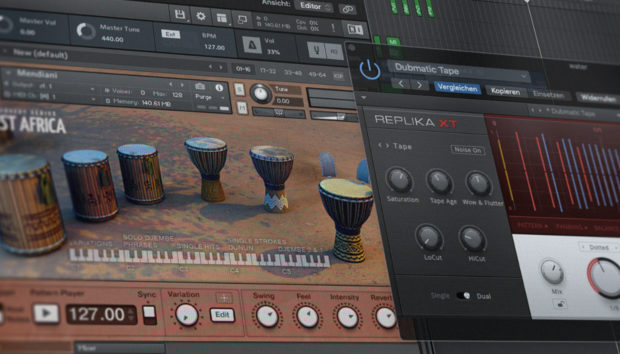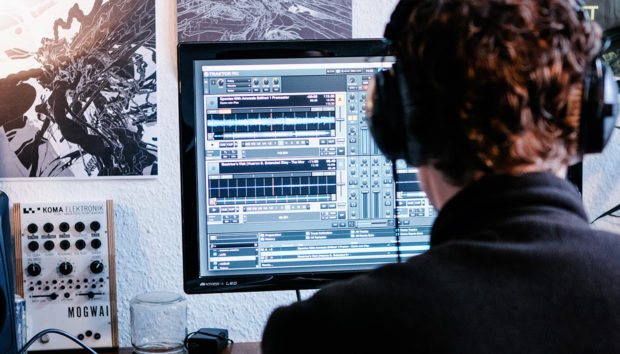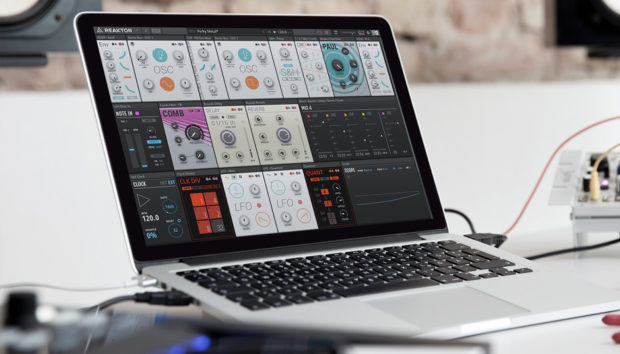iorie has been a fixture in Berlin’s downtempo and slow house scenes for years, putting out records that balance groove, melody, and a tight sense of arrangement.
Tracks like “Golden Spree” and “What Is Downtempo?” helped carve out his lane early, leading to releases on labels like Watergate Records, Ritter Butzke Studio, and Hoomidaas, and bookings across Europe, Asia, and the Americas.
His creative process mirrors the same approach: straightforward, flexible, and rooted in sound design choices that keep the workflow moving. Reaktor plays a big role in that. Instead of forcing tracks into rigid structures, iorie uses generative techniques, randomization, and modular ideas inside Reaktor to let sessions evolve naturally – finding ideas he wouldn’t land on through planning alone.
In this interview, iorie breaks down how he uses generative music tools, how Reaktor fits into his sessions, and the specific techniques that help him keep unpredictability feeling intentional.
Jump to these sections:
- How iorie defines generative music in his creative process
- How he uses Reaktor’s factory ensembles and Blocks
- The modules he leans on for fast generative ideas
- How to process generative sounds without overloading them
- Thoughts on generative techniques in broader electronic music
- Practical advice for producers starting with generative music
Stick around for a real-world look at how experimentation, selection, and smart processing keep his tracks feeling open without losing direction.
Generative music is a concept that gets thrown around a lot – how do you define it in your own creative process?

Generative music is for me defined as music that is not made with a specific intention, but rather generated by a synthesizing structure and then selected.
I rarely do fully generative music, but I think those pieces can be a huge inspiration and often end up as the backbone of my productions.
It is a spark of creativity that is beyond my usual realm and that can set me onto new tracks that I otherwise wouldn’t have got to.
Pro tip from Iorie: Use a tuner while listening to your generative sounds to get it right with other musical elements.
Do you use Reaktor’s factory ensembles, or do you build your own from scratch?
I use some of the Reaktor factory plugins and sound generators as well as some prebuilt patches from Reaktor Blocks. The factory plugins are insanely powerful sound generators that can spark a lot of creativity, but they have a quite distinct sound.
Reaktor Blocks is its own modular synth world.
The prebuilt patches can be a good inspiration to start your own block creations or just further build on those structures. When you have a rough understanding of modular synths you can easily build patches with Blocks yourself. It has Blocks like the Flip Gen that are just made for generative sound design.
Pro tip from Iorie: Don’t overcomplicate things – start by altering existing patches before building your own from scratch.
What’s a Reaktor module or feature that feels like a cheat code for generative music?

The generative cheat code is the “Metaphysical Function A&B.” I just let it run and record the output in Ableton until I hear something cool. Then I often only quantize it and EQ it a little bit, and the backbone of a track is done.
Pro tip from Iorie: Changing the sample selection in the Metaphysical Function manually (instead of using the randomize button) can bring nice results.
Do you process generative Reaktor sounds differently than more traditional synths or instruments?
Working with generative sound patches has inspired me to process traditional synths in a similar way to how I work with generative sound.
So re-recording, warping, quantizing, and so on. I tend to use fewer effects like delay on generative sounds because they are complex enough on their own.
Processing them more would make them feel overboard again.
Pro tip from Iorie: Many generative sounds contain subharmonic frequencies, so remember to low-cut those sounds to clean up inaudible clutter.
Do you think generative music has a place in mainstream electronic music, or is it more of a niche tool?
I guess the first kind of generative music tools already exist.
Some algorithms can spit out endless MIDI files for soft piano music, which is really popular on Spotify. We will see where it goes with AI music, which you could also consider generative music.
But I think intentionless music will mostly serve intentionless moments. Only by selecting a specific moment and weaving it into a larger narrative can you imbue it with intention. This, on the other hand, is a big chance for popular music. Music is sounding more and more the same, so generating new ideas outside of usual thinking can be the refreshing spark that a lot of music needs.
What advice would you give to someone who wants to start making generative music but doesn’t know where to begin?
Reaktor is actually a great place to start with generative music.
With the prebuilt patches and some of the preset sound generators, you can get an idea of how generative sounds work. The building blocks are quite an intuitive way of diving into modular synths that isn’t as overwhelming as VCV Rack can be.
However, you still have the opportunity to delve very deeply by building your own patches and modules with the Reaktor Build Page – although I don’t fully understand that aspect myself yet.
Pro tip from Iorie: Record and process the audio of generative sounds to make them feel more musical and a little more intentional.
Wrapping it all up
Big thanks to iorie for breaking down a real-world look at generative production. What stands out is how clearly he treats randomness as a tool – not a gimmick, not a shortcut, but a way to push his ideas into places they wouldn’t naturally go. It’s not about giving up control; it’s about choosing when to step back and let the system lead for a while.
Whether it’s flipping through Reaktor Blocks or recording a few minutes of random output to find something worth building on, the goal stays the same: keep the workflow moving, trust the results when they land, and sharpen them into something that feels intentional without killing the original spark.
For anyone looking to get more out of generative setups, the takeaway is simple: don’t wait for perfect. Set it in motion, listen for the good parts, and commit.
















